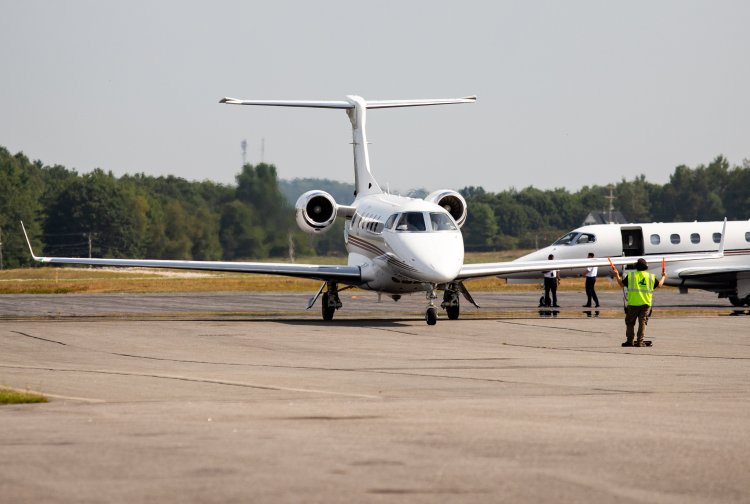
AUBURN — The Auburn-Lewiston Municipal Airport continues to make steady strides forward with its financial health and stability, with the most recent data on fuel sales showing a mixed bag, yet an overall improvement over recent years.
Fuel sales remain an important barometer of the financial health of general aviation airports and are closely correlated to the level of activity there. The airport sells two types of aviation fuel: Jet A fuel and avgas, or aviation gasoline, which is high-octane and low-lead.
For fiscal year 2025, which ended June 30, the Auburn-Lewiston airport reported increased avgas sales and lower jet fuel sales.
Avgas sales for the year totaled 53,514 gallons, a 58% increase over the previous fiscal year’s 33,887 gallons. That is the highest total sales of avgas at the airport since 2016.
Airport Director Jonathan LaBonte said there are several factors driving the increase. “First and foremost, we’re fortunate to have Chickadee Aviation — a flight school — here,” he said Thursday. “They’re by far our biggest customer.”
Chickadee moved to the airport in January 2024 and has been drawing student pilots from around the region in addition to offering scenic flights.
LaBonte also cited the return of general aviation pilots based at the airport. Many were driven away by poor customer service and past poor management practices that Labonte is credited with turning around.
The airport is also home to three aviation maintenance companies — Dirigo Aerospace Solutions, Skyward Aviation and Sunbird Aviation Maintenance. LaBonte said they are key to drawing more pilots to base their planes in Auburn.
Sales of jet fuel last year totaled 79,457 gallons, a 32% drop over the previous year and the lowest total sales since 2016.
LaBonte said June was a soft month, but traffic has picked up considerably since then, especially jet traffic, which LaBonte said is up 50%-60% in July over last year. Jet fuel sales were off in the region 10% or more during the peak season from 2023-2024, while Auburn’s sales were down 7%.

The height of fuel sales come between May and October as pilots ferry seasonal visitors in and out of the airport. A number of jets flew in and out of the airport on Thursday along with a steady stream of smaller planes.
Mark McGhee of Dirigo Aerospace said he’s seen more jet traffic lately from out-of-state developers and others.
“There are folks that fly in like the single-piston aircraft that will burn the 100 low-lead,” LaBonte said, referring to avgas. “They may bring a kid to camp. They may bring a prospective student to come check out Bates or maybe bring a student back to Bates. We get quite a bit of that. And obviously, the better weather invites the folks to fly more than they would in the winter.”
The installation last year of a 24-hour, self-serve pump for avgas is also a positive factor, allowing pilots to fill up outside normal business.
Marc Blais, a longtime proponent of the self-serve pump and an airport board member, said the self-serve pump has exceeded forecast numbers. “After-hours sales is a bonus,” he wrote in an email. “I have had nothing but positive feedback.”
LaBonte said 15% of avgas sales are occurring outside the 8 a.m. to 5 p.m. business day, which translates into income that was not coming in before. “In real numbers, this means in the eight full months the self-serve has been online we’ve sold over 5,000 gallons and generated nearly $31,000 in revenue outside of business hours,” he said.

Pilot Skip Varney, who flew in from Charlotte, North Carolina, to see family, said the self-serve pump is a welcome addition for pilots like him. He said he is originally from this area and used to be based at Auburn before his retirement.
Not every jet that lands at Auburn buys fuel, so the airport has implemented a facility fee for those aircraft to help offset the cost of handling landings and takeoffs and is something most airports charge.

Increased fuel sales help the airport’s bottom line, which is improving and has shifted from in the red to black. But LaBonte cautioned that is only a budgetary level of break even.
“We’re in the black that we budgeted, and we outperformed the budget,” he said. “We still require an operating subsidy from both cities.”
One of the biggest holes comes from the continued debt owed for the airport’s largest hangar, No. 5, which was supposed to be covered by Elite Airways when the commercial airline leased the hangar starting in 2019. The company left abruptly in the summer of 2022, leaving the airport and the two cities that support it to pay off the debt, which is now extended beyond 2045 with an annual payment of $60,000.


We invite you to add your comments. We encourage a thoughtful exchange of ideas and information on this website. By joining the conversation, you are agreeing to our commenting policy and terms of use. More information is found on our FAQs. You can modify your screen name here.
Comments are managed by our staff during regular business hours Monday through Friday as well as limited hours on Saturday and Sunday. Comments held for moderation outside of those hours may take longer to approve.
Join the Conversation
Please sign into your Sun Journal account to participate in conversations below. If you do not have an account, you can register or subscribe. Questions? Please see our FAQs.